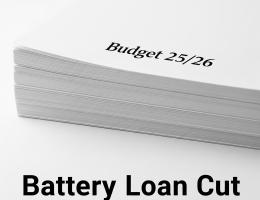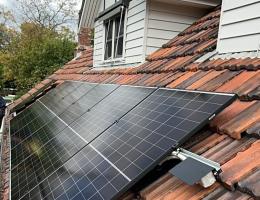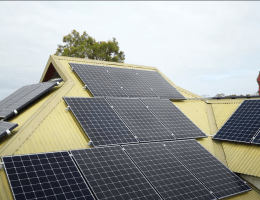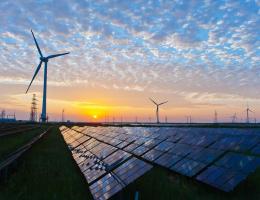
We all want to be off the grid, well at least not reliant on the grid. By being less reliant on the grid there is a powershift from the energy retailers to us. But that doesn’t mean we’d want to totally abandon the grid as the grid offers a huge opportunity to sell our excess solar to others who can’t access solar including commercial players or big industry.
Winter has always been a more difficult period for solar production in most parts of Australia. South of the divide solar panels produce 60% less energy in Winter than in Summer. Making your system 250% bigger doesn’t necessarily solve this problem but it is on the right track. Winter’s reduced production is a combination of two things. Shorter days, and cloudy wet weather. The cloudy wet weather is the main problem and with today’s solar panels being 90% cheaper than 20 years ago it is a cloudy winter day that many people design their solar system for.
Design point, winter under clouds….
This is where you pursue the ambition of no grid reliance, maximizing your exports so the retailers pay you and you only have to pay them for anomalous events like equipment failure of dark cloud cover for 4 days.
Batteries are still relatively expensive. Tesla’s cell costs are at USD $200/kWh but the batteries, which have seen a price rise this year, are selling at $1030/kWh installed. This will turn around and battery costs should dive over the coming decade towards $20/kWh at the cell level. But there’s still quite a lot of cost wrapped up in the 'balance of plant' i.e. the inverter, battery management and cooling that comes as part of a Tesla Powerwall or equivalent) battery system. As an aside Tesla recently purchased Maxwell technologies which should provide the technology and know how to make their batteries 20% more dense so, in the future, Tesla PW3 might offer 16kWh of storage in the same size box at the same price point. In the end you could imagine $20/kWh at the cell level translating into a retail offering of $200/kWh including 'balance of plant' which again translates to a Tesla PW3 priced at $3500. But that is some time off.
In the meantime, for your winter design, you need to think energy efficiency and when your mind is drifting somewhere else (like an ever bigger system) think energy efficiency again. It’s a lot cheaper to not use the energy than to have to produce it under cloudy conditions then store it in pricey batteries. The good news is that the most efficient products on the market can help you become super efficient. The Sanden CO2 heatpump is number one in efficiently producing hot water and it comes with a thermal storage (sometimes thought of a a hot water battery). A hea tpump hot water service such as the Sanden costs $1500-$3000 more than a conventional hot water service depending on where you live and what subsidies you can get. But think of the Sanden as a 2-4kW solar system (in that it extracts energy from ambient air) that runs when the sun is not shining combined with battery storage (thermal only but that’s what you need every day with hot water). The Sanden stores up to 20kWh of heat for $75 - $150kWh a lot cheaper than today’s batteries at over $1000/kWh.
For heating and cooling, as I’ve said previously, the leading Japanese inverter models are the only way to go and use 75-83% less energy than a conventional electric heater and 87% - 92% less than an old ducted gas heater. The best of the bunch are the Mitsubishi Heavy SRK20ZSXA-W 2.0kW and The Daikin US7 2.5kW and 3.5kW (rated for heating at 2.7, 3.5 and 5.0kW respectively). Smaller units are best, if you’re being told you need a 7kW+ system, either your home leaks heat like a sieve or the person quoting you your AC unit hasn’t taken into account all the great things you have done or will do to insulate your home.
On tightening the building envelope your motto should be, do it right do it tight. Get rid of draughts if you can. If you’re house is super tight you might need an energy recovery vent ERV or HRV for fresh air but for most households that’s a long long way off and going on an draft sealing mission will just generally improve thermal performance. Insulation all round your home's thermal envelope is the way to go. If you’re a really serious DIY type (and your particular building type requires it) get yourself a LED headlamp and Makita 18V portable staple gun, turn the power off to the house and get going installing insulation in your roof and sub floor. But remember to turn the power off before you go stapling away and be mindful of stapling near any cables.
Back to your solar system, a winter system is a big system and combined with a battery (if your situation demands one) can achieve a very good rate of return. Your solar install should cost a third of what they did back when the so-called generous 50-60c/kWh feed in tariffs were available(I don’t believe they were generous – I believe they were what was required at the time to get the solar revolution kickstarted). Currentlya 20c/kWh feed-in-tariff is available in most parts of Australia and will give you similar returns on your 3 -5x larger system than what people were getting back in the hey-day of high feed in tarrifs.
So your big solar system is quite simple for a 1 phase home (about 90% of Australian households) and consists of: a 10.8kW solar system on a Fronius 8.2 inverter or a 13.3kW system on Solaredge HDWave 10kW inverter. Of course going even bigger than this is ok but you’ll need a second inverter. Grid export limiting is available on most networks. WA and Ausnet in Eastern Victoria being the worst and most restrictive. For a 3P home, or you want to upgrade from 1P to 3P,, a 10.8kW solar system on a Fronius 8.2 Symo inverter, 13.3KW on a Symo 10 or a20kW on a Symo 15 works. And of course, you can always get another inverter. Most networks will allow up to 30kW of inverter capacity without too much fuss.

As some networks are being unreasonably restrictive i.e. the recalcitrant Ausnet. there may be a requirement for a certain amount of civil disobedience and not getting an approval for your Tesla battery connection (which would be not allowed if you have a 10kW solar system) might fit that category. I don’t call for breaking rules lightly but the Ausnet ban on Tesla’s is crazy and very unfair. A customer with a Tesla PW2 reduces her impact on the network significantly more than one without one, so why would they effectively ban them? The answer sadly is self interest and protecting their rapidly dating business model . In effect this is Singapore International and China State Grid telling Australians they can’t have solar and storage. This is an outrageous example overseas meddling in Australia's affairs, our politicians need to do their job and stand up against it.






